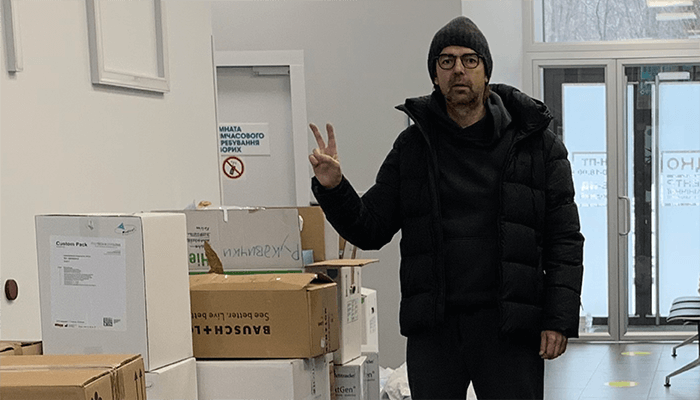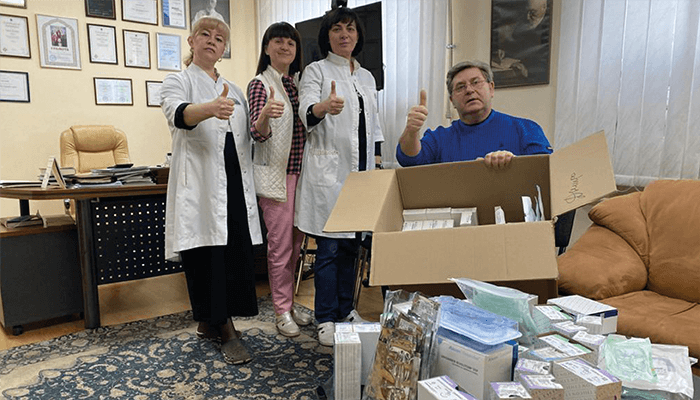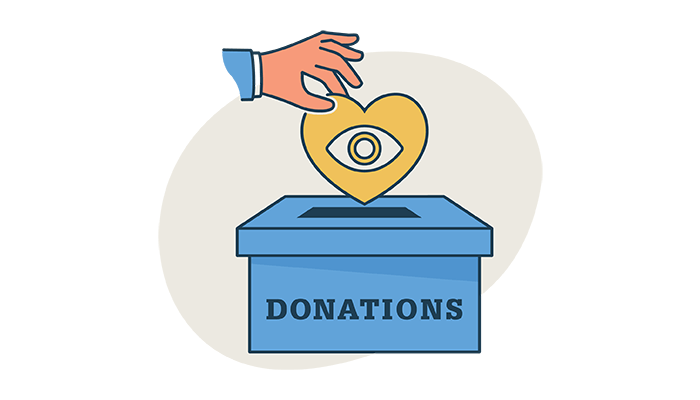
How are efforts to build a steady stream of donations as the war in Ukraine rages on? Aleksandra Jones speaks with Andrzej Grzybowski, Professor of Ophthalmology and Chair of the Department of Ophthalmology, University of Warmia and Mazury, Olsztyn, and Head of the Institute for Research in Ophthalmology, Foundation for Ophthalmology Development, Poznań, Poland.
We will soon pass 100 days since the Russian invasion of Ukraine. When the war first began, what did you and your colleagues do?
Andrzej Grzybowski: As the largest country directly accepting Ukrainian refugees, Poland greeted millions of people in the first days and weeks of the crisis. It is estimated that since February 24, over 3.5 million people have crossed over from Ukraine to Poland. In those early days, it was an “all-hands-on-deck” approach; people were organizing themselves to offer targeted help in Poland and within Ukraine.
For me and my colleagues in Poland, the first reaction was also to immediately offer shelter to the eyecare professionals from Ukraine that we had been working with. I reached out to my close collaborators in Lviv, including Ihor Novytskyy (Professor at the Lviv National Medical University and Head of the Lviv City Medical Centre Eye Surgery), Andrii Ruban (President of the Ukrainian Vitreoretinal Society in Kyiv), Valery Serdiuk (Professor of Ophthalmology in Dnipro), and Andrii Korol (Head of Laser Division at The Filatov Institute in Odesa). Up until then, I had regularly been taking part in ophthalmic conferences with colleagues from Ukraine and I would visit the country a few times every year. We also worked on research projects together.
However, my clinician colleagues would not leave a country where they were so needed. They felt very strongly that they had to defend their homeland, and support troops and the general population medically as much as they could.
Read the interview with the President of the Ukrainian Vitreoretinal Society, Andrii Ruban.
So, what did you decide to do?
Quite soon after, we – Polish ophthalmologists – began exploring ways of helping out with donations, including money and medical supplies. I contacted Zbigniew Zagórski, a professor of ophthalmology who runs a network of private ophthalmic surgery clinics in south-eastern Poland, and ophthalmic specialist Agnieszka Kardaszewska from Nowy Sącz in the south-east of the country; together, we prepared a list of medical supplies most needed by ophthalmologists in Ukraine – both in the clinics that were still functioning and by those dealing with trauma cases resulting from the military action. We contacted all university clinics in Poland, our network of around 1,500 Polish ophthalmologists, and industry partners to ask them for donations of equipment and consumables to be sent across the border. One of Zagórski’s clinics has acted as a distribution center and we were able to provide its address to all our contacts who wished to help. Kardaszewska arranged for these supplies to be regularly delivered to Lviv, where they were further distributed around Ukraine, wherever they were needed.
Very quickly, colleagues outside of Poland began asking how they could help. It made no sense to send equipment and supplies from the other side of Europe or even from across the ocean (I had some colleagues call from as far as Canada, USA, and Japan), so we decided that we needed to enable financial donations.
We decided to set up an account where colleagues could transfer funds that will be used exclusively to help Ukrainian ophthalmologists (see details below). We have received some donations, including one on behalf of the Japanese Retina Vitreous Society from its President, Taiji Sakamoto, one on behalf of the Eye Foundation of America from its President and Founder, V.K. Raju, and some from individual doctors from across the USA. We thank societies that decided to share information about our support system, including the Retina Society, American Glaucoma Society, Japanese Retina Vitreous Society, and the American Academy of Ophthalmology.
You have been speaking with your colleagues in different parts of Ukraine – what has life been like?
It really depends on where in the country they are. For those in the West – like Lviv – life has been carrying on, with clinics still operating almost as normal. Those in occupied parts of the country, like Kharkiv or Kyiv earlier, or Mariupol, have been dealing with many trauma cases and their practice or research has been – for the most part – interrupted. Fractured logistics and distribution chains have affected all medical professionals in Ukraine, and that’s why it’s crucial that we continue to send medical equipment, tools, and supplies. It has already been almost 100 days since the invasion started – and there is no end in sight. We also have to remember that, even after the conflict ends, Ukraine will still need a lot of outside help. Large parts of the infrastructure have been or will be destroyed, and it will take a long time before the country can function as it did before. And that’s why it is vital that we keep on talking about this, and bringing it to people’s attention regularly. The international ophthalmic community needs to work out long-term systemic solutions so that help is offered to Ukraine for as long as it is needed.

You have some practical information to share…
Yes, we collect supplies in Rzeszów, Poland; the city has an airport and parcels can be sent via airmail. We send supplies further to Ukraine via the Mountain Rescue Service across the Polish/Ukrainian border. Aid can also be sent directly to Ihor Novytskyy in Lviv.
For monetary donations, a special account only for support for Ukraine has been set up by Foundation Okulistyka 21.
All relevant contact details, addresses, and the bank account number/PayPal details can be found on https://okulistyka21.pl/2022/04/13/support-ukraine/ and you are welcome to contact me directly at ae.grzybowski@gmail.com.
Have you had any feedback from colleagues in Ukraine on your efforts so far?
Yes, a few weeks after the invasion began, I received this letter from the Union of Ukrainian Ophthalmic Surgeons:
“Dear colleagues!
Thank you very much for your support and for your efforts in collecting medical goods for us. We sincerely appreciate it! We have received your generous donations.
Many Ukrainian hospitals are now working very close to the fighting zone. They send us information about their necessities for medical care there and we collected all our needs below in an attachment. Your help is very important for our people.
Our humanitarian hub in Lviv is working in coordination with Lyubomyr Lytvynchuk [Head of Vitreoretinal Service at the University Clinic Giessen and Marburg, Germany, originally from Ukraine].
Thank you very much. Together, we will end this aggression against Ukraine and Europe!”

Ophthalmic supplies needed in Ukraine
Consumables:
- Sutures Nylon, 10.0 and 9.0 (for suturing anterior segment wounds)
- Sutures Vicryl, 4.0 to 8.0, for posterior segment wounds
- Sutures Mersilk, 3.0-6.0, for skin wounds (eyelids, eyebrows, face)
- Sutures Prolene, 3.0-5.0 and 10-11.0, in straight and curved needles
- Fluids, Ringer solution, 0,09% NaCl, mutlelectrolyte solutions, 5% Glukose (500 ml) – any type of crystaloids (250-500-1000 ml)
- Viscoelastics - Methylcelulose, Hialuronic acid (type PH-Luron, DuoVISC, Viscoat, Healon or others -1.4; 1.6, 1.8, 3.0) – any type
- Aqua pro injection (small vials)
- Infusion lines for intravenous use
- Syringes, all volumes
- Blunt canullas for fluid injections
- Hypodermic needles, different sizes
- Opthalmic chromophores as trypan blue or Triamcinolone, Indocyjanine Green, Brilliant Blue and similar
- Analgesics: 1% and 2% Lidocaine Bupivacaine or similar, also Lidocaine in gel
- Slit and paracentesis knives
- Sterile operating field covers
- Antibiotics: Moxifloxacine (Vigamox), Aprokam, Levofloxacine, Vankomycine, Amikacine, Cefuroxime, TriMOXI, TriMoxiVanc or similar
- Steroids: Dexamethasone, triamcinolone
- Antibiotics/steroids, drops for example: Tobradex, Mybracin, Ducressa and similar
- Anaesthetic drops, Alcaine, proparacaine or others
- Ophthalmic sponges
- Sterile compresses and pads
- Ointments steroids/antibiotics or antibiotics for example: Dexamytrex, Floxal, Tobrex Maxitrol etc.
- Adhesive tapes
- Gauze compresses
- Surgical gowns
- Masks and caps
- Gloves, different sizes, sterile and non-sterile
- Disinfectants: Braunol, Betadine
- H202, soap, hand disinfection
- Decaline and silicone oil (any type).
Ophthalmic equipment that can be sterilized:
- Endomagnet for intravitreal use (20-23 Gauge)
- Eckhardt microforceps, Crocodile forceps
- Cassettes for CONSTELLATION
- 23 G sets of cannulas for vitrectomy (as many as we can get)
- Microforceps, needle holders
- Portable slit lamp
- Plasma adhesive centrifuge (PRP, PRF, ACP) to prepare fibrin glue.
